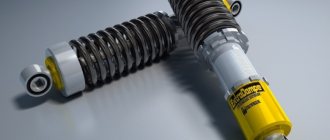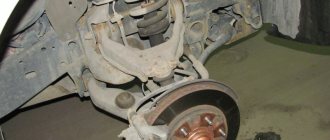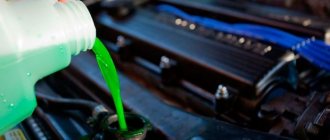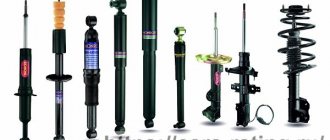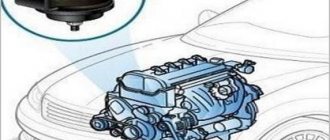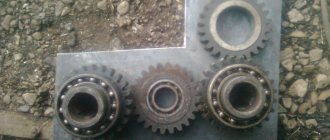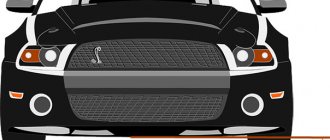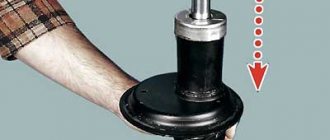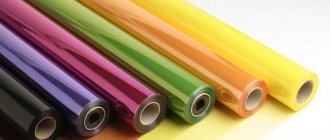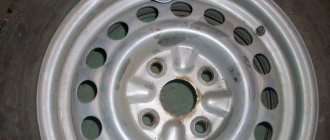One of the important elements of an automobile mechanism, the main function of which is to dampen sharp vibrations that appear during movement, is a gas (oil) shock absorber. Such vibrations are a consequence of the effect of the suspension (or other moving parts) on the car body, which appear when the vehicle moves.
If there were no shock absorber in the design of the car, then uniform movement would become an extremely problematic task and with the slightest increase in speed, the body would begin to sway, thereby disturbing the overall balance of the car. As you can see, it is impossible to do without such an element of the running system, and you can learn more about the principles and conditions of its operation by reading to the end of this article.
Gas shock absorber: principle of operation and importance of pumping
To define the term “gas shock absorber” , there is no need to come up with complex terms, because we can simply say: this is a device that uses gas to dampen vibrations, that is, it acts as an active substance. Unlike an oil shock absorber, gas is pumped into the design of a gas shock absorber under high pressure, and it is extremely difficult for it to pass through the small hole between the cylinder chambers, as a result of which the rod slows down its reciprocating movement, thereby compensating for body vibrations.
The design of the shock absorber provides for the presence of a cylinder, inside of which, in this case, there are chambers with oil and gas, as well as a piston that systematically rises and falls. Resistance to the movement of the piston is exerted by the pressure created by the compressed chamber filled with gas (since it is poorly subject to deformation), due to which smoothness and regularity are achieved, leading to smoothing of shocks.
The main advantage of a gas device is higher pressure than in an oil installation, which is expressed in additional rigidity. Thanks to this factor, an increased level of reliability and stability of traction with the road surface is achieved, especially when driving at high speeds.
To increase the service life of a gas shock absorber, it should be pumped before installation, as a result of which the service life of such units increases by 40%! and, compared to oil counterparts, it becomes possible to withstand more severe loads. However, you should start performing such an operation only if you know exactly what and how to do. For example, all actions must be performed in a strictly vertical position (with the rod down), and it must remain in this position until it is in its place. Also, do not forget that pumping is carried out at least 2-3 times, and some types of shock absorbers require up to 8 repetitions. Such actions have a positive effect on the valve mechanism, protecting it from jamming and other malfunctions. The lack of pumping can have a negative impact on the operation of the shock absorber piston system and if, for example, a two-pipe gas device stopped working, and no one pumped it before installation, then it is quite possible that the reason for this was the air remaining inside the liner.
What other gas shock absorbers are used in a car and how to choose them correctly?
Nowadays, gas shock absorbers are widely used not only in the vehicle suspension system, but also in various mechanisms for opening parts of its body. Of course, they are not as adapted to loads as “suspended” ones, but they don’t need this, because the task before them is completely different. So, for example, a gas hood shock absorber is not able to withstand heavy loads, so its design differs from that of conventional models: it should not be very short, because if to check the oil level in the engine or brake fluid, the height of the open hood lid will be enough, then to access all internal parts of the engine, this will not be enough and a short rod will only get in the way. Based on this, when purchasing a gas hood shock absorber, you should be prudent and take into account all possible operating conditions.
In the case when it is necessary to choose a shock absorber for the luggage compartment, first of all, you need to be guided by the degree of intensity of its use. If the trunk is used frequently, then you will not find a better option than gas shock absorbers. Despite the fact that this is a rather expensive design, when used correctly, it is characterized by comparative durability and ease of operation. However, when choosing, you should take into account not only the frequency of use, but also the weight of the trunk lid, and for this it would be a good idea to look at the technical documentation of the vehicle. In addition, the quality of long-term use of trunk shock absorbers (and the hood, by the way, too) is affected by the ambient temperature. In winter, in cold or frosty weather, you should avoid opening them suddenly, as this will quickly destroy the shock absorbers (this statement mainly applies to oil and oil-gas mechanisms, while purely gas ones, in this regard, have some resistance). The need for a smooth opening is due to an increase in the viscosity of the working substance; accordingly, in order for the shock absorbers to do their job correctly, they will have to help a little with this.
When choosing a shock-absorbing device for the rear door, you should select a mechanism that has a greater buoyancy force than similar parts of the trunk and hood, so before purchasing them, you should carefully study the instructions, or even better, seek advice from a specialist.
Gas shock absorbers, for all their advantages, also have a number of disadvantages that can play a decisive role in the selection situation. The main one is the high cost, which often exceeds the price of oil-based devices several times, but if you take into account the price-quality ratio, then, in principle, you can put up with this disadvantage. The second common problem with such parts is the limited repair action, that is, if the gas structure is faulty, then most likely it will have to be replaced completely, since if one shock absorber breaks down, it is strongly recommended to replace its pair.
How to bleed a gas shock absorber - useful tips
Before installing any new shock absorber on a vehicle, it must be brought into working condition. The reason for this need is the fact that during storage and transportation, working fluid can flow from the inner cylinder into the outer one, and boost gas can flow into the inner one. In such cases, when the shock absorber is operating, you will be able to hear a characteristic knocking sound that accompanies the destruction of the throttle valves. Therefore, to avoid damage to the parts of the piston mechanism of shock absorbers, they must be pumped before installation. It should also be borne in mind that some devices have drain mechanisms used to remove oil from the system, but this mainly applies to oil shock absorbers.
If you decide to bleed the gas shock absorber yourself, we will provide you with detailed instructions on the necessary steps:
We recommend: Operating principle of the injector
— install the part in a vertical position, with the rod down (turn it up, relative to its future position in the machine) and, without sudden movements, squeeze it all the way, holding it for 2-3 seconds;
— without changing the position of the shock absorber, turn it upside down and fix it in this position for 3-6 seconds;
— after the specified time, leaving the shock absorber in the same vertical position, smoothly release the rod until it is completely straightened (until the end of the stroke);
— now turn the shock absorber over again (rod down) and hold it in this position for 2-3 seconds, after which you should repeat the operations specified in points 1 and 2 at least 5 times (preferably 8). As a result of such actions, the stroke of the rod should become smooth, without unnecessary jerks and slips; only in this case can we say that the pumping was done correctly. Also, by the “twitching” and jerky movement, you will be able to notice whether this part has been used or has been in a non-working, lying position for a long time.
Note! In some shock absorbers, when fully decompressed, the valve mechanism is able to enter the compensation cavity, which is intended to expand the shock-absorbing fluid during heating.
After pumping is completed, the shock absorber is held in the working position vertically, with the rod up, directly until it is installed on the car. It is strictly not recommended to tilt or turn the device over before this point.
Many car enthusiasts carry out installation immediately after purchase, without proper preparation in the form of pumping; in such cases, the service life of shock absorbers is reduced by 3 to 5 times, but even during this time they cannot fully perform their functions (that is, they do not work correctly), which in turn turn, leads to rapid wear of all parts of the depreciation system and its complete failure.
Subscribe to our feeds on social networks such as Facebook, Vkontakte, Instagram, Pinterest, Yandex Zen, Twitter and Telegram: all the most interesting automotive events collected in one place.
How to distinguish a shock absorber from a strut
A fairly common opinion, especially among novice car enthusiasts, is that a strut and shock absorber are just different professional names for the same element.
Moreover, even in professional stores, many consultants will not give you a clear explanation or will even claim that these names are just synonyms.
This misconception and unprofessional opinion only confuses car owners
A clear understanding of the structural features and functionality of structures is extremely important, since the differences are striking, including in price
To understand the features of each individual type of part, it is worth carefully considering them in turn.
A shock absorber in a general sense is a set of components, the main function of which is high-quality and soft damping of vibrations of the frame, and, accordingly, the car body.
This significantly increases driving comfort and allows you to avoid an increase in dynamic impacts while effectively smoothing out shock from the road. Structurally, the unit is an oil pump.
The hydraulic fluid in it moves through a small hole, creating the necessary resistance to dynamic vibrations.
Working together, the oil pump and spring provide the necessary stability of the vehicle. This allows you to eliminate “squats” or “dive” of the car even when you sharply press the brake or pick up speed.
If we explain everything by a physical process, then kinetic energy turns into thermal energy, the resonance of vibrations fades, and the driver and passengers enjoy comfort.
If the shock absorber is damaged in any way, the connection with the spring and suspension is lost, and the tires wear out much faster. The car brakes worse, and the overall contact with the road drops so much that the breakdown needs to be repaired as quickly as possible.
The swaying body also does not add ride comfort. It is worth noting that in some shock absorber designs a spring is not provided and its functions are assigned to the hydraulic unit.
As for the design features of the strut, this can already be considered a direct and full-fledged element of the vehicle suspension itself. And she has a corresponding task. The rack is responsible for the direct connection of the car body and wheels.
High-quality grip on the road also refers to the direct functions of this unit, as well as working with lateral loads. Resistance to uncharacteristic side effects is made possible by the use of a thick stem as well as a corresponding high quality damper alloy.
It is precisely due to the use of special material and other design solutions that the rack costs much more. A similar feature of the two components is that the unit, like a shock absorber, can also be coupled with a spring, or work in its absence.
Having detailed knowledge about the features of each node, you can draw your own conclusions about the differences, advantages and preferences in choice.
An integral distinctive feature of the unit is the most rigid fixation with bolted connections on the lower part. The upper element is connected to the rotating part.
The shock absorber is attached at the bottom directly to the silent blocks. The upper component is mounted to a non-rotating fixed unit. In general, the thickness of the shock absorber rod is slightly smaller.
When choosing, it is worth considering the differences in the operating principles themselves. The shock absorber copes excellently with loads whose vector extends along the axis of the body. Blocking occurs when released.
The rack is adapted to work with loads from a wide variety of impact vectors. The mechanism itself is equally effective both during compression and during expansion.
It is worth noting that due to many additional functions and operating features, the rack requires a more attentive attitude to the technical condition and timely maintenance.
Shock absorbers in a car suspension: how are they designed and how to change them?
What is a shock absorber used for?
To begin with, let’s “separate the flies from the cutlets,” that is, let’s understand the roles of the different suspension elements.
On most modern passenger cars, the main elastic elements are springs. 30–40 years ago, this role was mainly performed by springs, working “part-time” and as dampers. The vibrations were successfully damped due to friction between the spring leaves. We won’t go into detail about the shortcomings of springs and their typical problems; we’ll devote separate material to them, but now let’s just remember their existence and return to springs. They are installed between the suspension and the car body and are designed to absorb shocks to the body coming from the road. When the wheel rolls onto some obstacle, the spring is compressed, and the body moves only slightly and smoothly upward, the wheel rolls off the obstacle - the spring straightens.
There is, however, one unpleasant moment. Let’s take, for example, a bouncy toy – a rubber ball, which can also be classified as an elastic element. Hit him on the ground and time him until he stops jumping completely. Your car will jump approximately the same way if its suspension design contains only levers and springs. And, depending on the stiffness of the springs, the suspension will be either stone or soft, like cotton wool, but in either case you don’t even have to think about the car’s handling. The worst thing for such a suspension is resonance, when vibrations enter it they can destroy individual elements of the suspension and its fasteners.
The problem was solved by introducing a shock absorber into the suspension design - an element that allowed the wheel to move relative to the body, but prevented the car from rocking. Initially, these were lever-type shock absorbers, which, like springs, performed their function due to friction. But we will not dwell on anachronisms; we will consider only modern designs. At the moment, the “mainstream” for passenger cars is telescopic hydraulic shock absorbers. This time we will not take pneumatic and hydropneumatic systems, as well as shock absorbers of variable stiffness - these are topics for separate articles.
Operation of the telescopic shock absorber
To simplify it as much as possible, the operation of a shock absorber can be described as follows: there is a cylinder filled with oil, a rod with a piston moves inside the cylinder. This piston has valves that open in one direction only.
When the piston moves down, some valves open and liquid flows into the cavity above the piston; if the piston moves up, other valves open and liquid flows into the cavity under the piston. Damping of vibrations occurs due to the fact that the oil does not compress and has a certain viscosity.
By the way, why are valves needed at all? Maybe holes would be enough? Actually, not enough. One of the important characteristics of a shock absorber is its rebound and compression stiffness. In other words, it is the resistance on the shock absorber rod as it is pushed or pulled out of the body. Valves are needed to regulate this rigidity.
Due to the different flow characteristics of the valves, it is a little easier to press the shock absorber rod in than to pull it out of the shock absorber. This was done with the expectation that when hitting an obstacle, it is necessary not to interfere with the wheel moving upward in order to prevent the transfer of shock from the wheel to the body. In this case, the valves allow more oil to pass through. But if there is a big hole on the way, then the wheel should be kept in a “tucked” state, why rush to fall into it? Therefore, the damper valves allow less oil to pass through.
Once again: valves are needed to set a certain stiffness of the shock absorber in different directions of its operation.
Types of structures
Structurally, shock absorbers can be divided into three main types: two-pipe, two-pipe with gas pressure and single-pipe with gas pressure. Twin-pipe hydraulic shock absorbers were the first to appear on cars. In them, as the name suggests, there are two pipes - cavities, in one of them (inner) there is a piston with the above-mentioned valves, the other (outer) is necessary to compensate for the volume of oil - it is only partially filled with oil, the rest is air.
During operation of the shock absorber, the oil inside heats up to high temperatures, this causes it to expand, and so as not to squeeze out the rod seals, the liquid flows into the outer cavity.
This type of shock absorbers has few advantages: they are cheap and have little impact on their operation from dents on the body. It is also worth mentioning the good smoothness of the car and the relatively low rigidity of such shock absorbers.
The disadvantages include overheating of the working fluid, since the body is double, and cooling with atmospheric air is difficult. Due to overheating, there is a high probability of oil foaming and, as a result, an immediate loss of operating efficiency - the shock absorber ceases to perform its function, and the car becomes poorly controlled due to rocking.
Articles / History Softness and hardness of the suspension - what is more important for comfort? Almost every car owner is sure that a soft suspension provides comfort, while a hard one makes the car sportier and allows better grip on the road. But as in many other cases,... 86827 0 37 03/05/2015
The next disadvantage is the large weight of the twin-pipe shock absorber, as well as a strictly defined installation location - if it is turned over, the working fluid will leak out. The weight of the shock absorber affects the amount of unsprung mass (we’ll talk about what this is separately). The greater the unsprung weight, the worse the ride and handling of the vehicle.
A small improvement in twin-pipe shock absorbers was the filling of the outer cavity with gas with a slight excess pressure. In this way, the likelihood of foaming was reduced, since the oil in this case “rests” on the gas cushion.
Hydraulic monotube gas-filled shock absorbers are a completely different matter. One cylinder filled with oil, a piston with one-way valves and a small cavity filled with gas and covered by the piston.
A mono-tube shock absorber does not have all the disadvantages of a double-tube shock absorber. During intensive work, the liquid does not overheat, since it is separated from the environment by only one cylinder wall and is perfectly cooled. It is also lighter and can be installed either up or down.
But the laws of nature cannot be avoided: you win somewhere, you lose somewhere. Therefore, the advantages of double-tube shock absorbers have become the disadvantages of single-tube shock absorbers. The latter are much more expensive and very sensitive to mechanical damage to the body, therefore, operating a car with them, although not so much, is more expensive.
Installation of shock absorbers
The installation methods for shock absorbers have not changed since their introduction into cars. So, their upper part is always attached to the car body or frame, and the lower part is always attached to a suspension element, be it a lever or a continuous axle beam. Because of this, replacing this element in the vast majority of cases did not cause difficulties: I unscrewed the lower fastening bolt, unscrewed the upper fastening bolt, and that’s it, the shock absorber was in my hands.
With the shock absorbers of the rear suspensions everything remains the same, but with the front ones everything is a little more complicated. With the advent of front-wheel drive cars, the question arose of where to put the shock absorber, which was mainly attached to the lower arm of the front suspension and interfered with the installation of the drive shaft.
There were two main solutions to this problem. The first option is to install the lower part of the shock absorber on the lever through a U-shaped bracket, inside which the drive shaft passed. The second option is to move the shock absorber along with the spring to the space above the upper suspension arm. In this case, the lower part of the shock absorber is attached to the upper suspension arm, and this entire structure is named after the American engineer Earl Steely McPherson.
Articles / Practice Car suspension silent blocks: how they are designed and how to change them Why do you need “rubber bands” in the suspension, how to understand that they are worn out and how difficult it is to change them? Today we will study a little theory and go to a car service to change the silent blocks of the front arms V... 62661 1 23 08/18/2016
McPherson developed this fundamentally new type of suspension for the ultra-budget Chevrolet Cadet concept car in the 1930s. In practice, it was only possible to use it after the war, already on the 1948 Ford Vedette for the French market. Now that you know this short, exciting story and can show off your erudition on occasion, let’s move on to the features of this still popular design.
McPherson combined the shock absorber and spring into one shock strut. In this rack, the upper part has a hinge with a bearing and rests on a body element - the glass. Thanks to the support bearing, the stand can rotate around its own axis. And if you install the shock absorber strut at a certain angle, then you can set the trajectory of the wheel and the angles of its installation, such as camber, the angle of longitudinal and transverse inclination of the steering axis (we will definitely consider what this is in future publications).
It turned out that with this installation of the strut, you can get rid of the guide of the upper suspension arm, thereby reducing the cost of it. The steering knuckle in the suspension is attached to the ball joint of the lower arm and to the shock absorber strut, and rotates with it. The anti-roll bar in this case can be attached either to the lower arm or directly to the shock absorber strut.
If we consider the methods of attaching the strut to the steering knuckle, there are several of them. The steering knuckle can be attached to a bracket on the strut body. Often - two eccentric bolts with nuts, and they are also elements for adjusting the camber of the wheels. If the wheel camber is designed structurally, then adjustment is not needed, which means that the strut can be secured in the steering knuckle bracket. The mounting bracket in this version is an eyelet with a cut, which is tightened with one bolt. The simplest option is to press the strut housing into the steering knuckle (like our experimental Chevrolet Lanos). All this is often supplied as one part - assembled with a fist.
The list of disadvantages of the MacPherson strut includes relatively small suspension travel and, as a result, such a design is very rare, if not an exception, on real SUVs (however, there are almost no such cars left). And the reason is that with maximum compression of the strut spring, the wheel alignment angles begin to change very strongly, which entails a serious deterioration in the car’s handling and leads to excessive tire wear.
Articles / Practice Disc brakes: typical breakdowns and repairs Why do the pads “squeak” and why does the brake pedal vibrate? What causes a brake caliper to jam and what can be done about it if you don’t even have a repair kit at hand? We are studying the design of modern... 56780 3 26 08/10/2016
Shock absorber struts can be with or without the ability to replace the shock absorber. In the first version, the strut housing with the spring support is made separately from the shock absorber. In the second, the shock absorber body is simultaneously the strut body, and the lower spring support is mounted directly on it. The upper spring support is attached to the shock absorber rod. The spring at the top and bottom acts on the supports through rubber pads. An elastic bumper is installed on the shock absorber rod - a rubber or polyurethane bushing that prevents shock from the suspension parts when the spring is fully compressed.
The spring in the shock absorber strut is always under tension. Initially, compression is necessary to eliminate backlash and gaps in the assembly. Replacing a strut on a car is always a little joy for a mechanic, since the cost of the work is quite expensive.
Example of replacing shock absorbers
So, let's move on to the repair area, where the Chevrolet Lanos with its front collapsible shock absorber struts awaits us. We leave the old springs, but change the shock absorbers. The owner of the car decided that the standard twin-tube front suspension shock absorbers were too soft and it lacked handling. The solution was to install front monotube gas-filled shock absorbers.
Let's get started. Unscrew the nut securing the drive shaft to the wheel hub, then unscrew the mounting bolts and remove the front wheel. Next, to make it easier to unscrew the fastening elements, we spray the life-saving WD40 on the joints of the ball joint of the lever and the joint of the steering rod end.
1 / 4
2 / 4
3 / 4
4 / 4
Remove the cotter pin and unscrew the nut securing the ball joint to the steering knuckle. We loosened, but did not completely unscrew the nut securing the anti-roll bar to the stabilizer link (which is on the arm). After the connection had become slightly acidic under the influence of WD40, we unscrewed the nut securing the tie rod end to the eye on the shock absorber strut.
Under no circumstances should you hit the hinge pin with a hammer, so here you will need a universal puller - use it to disconnect the tip hinge. Since it is necessary to remove the shock absorber strut as an assembly with the steering knuckle and brake disc, the brake caliper must be removed. The operation is simple: unscrew the upper and lower guide bolts and dismantle the caliper. At the same time, the condition of the brake pads was inspected (they are fine). By the way, there is no need to even disconnect the brake hose from the caliper.
1 / 6
2 / 6
3 / 6
4 / 6
5 / 6
6 / 6
Next, disconnect the lower suspension arm from the steering knuckle. We did not have any problems with this, but if the connection becomes sour, it is recommended to use a universal puller. Having slightly pulled the rack towards you (its upper mount allows you to do this), we remove the drive shaft from the wheel hub. In this case, you must be very careful not to damage the CV joint boot.
We move from the wheel well to the engine compartment. Here we unscrew the nuts securing the strut to the body glass. No problems either. The only edification: hold the strut, because by unscrewing these nuts, you remove the last fastener connecting the strut support to the car.
1 / 3
2 / 3
3 / 3
That's it, the part is in your hands. Now we need to disassemble the shock absorber strut. To do this you will need a real special tool and certain skills in using it. Using two brackets and nuts from the device, we compress the strut spring. For God's sake, do not stand in front of the upper support at this moment, as there have been cases of the device being torn down. A spring that suddenly gets free action can fly off and, if not kill, then seriously injure.
After the spring has been compressed, unscrew the central nut securing the shock absorber rod to the upper strut support. We unscrewed the nut, removed the support and spring along with the special device. If the shock absorber in the rack was not replaceable, then the disassembly process would end here, but we have a separate shock absorber, and it is secured with a nut. We unscrew it with considerable effort and dispose of it, since a new nut is supplied with the shock absorbers. The equator has been passed! Assembly can begin.
1 / 2
2 / 2
We install a new shock absorber into the strut housing pipe. Install a new nut and tighten. Now, just as carefully as during removal, we fasten the spring still compressed by the tie back into place. By the way, carefully check the spring support rubber pads. Their integrity is the key to the durability of the rack assembly. If everything is in order, install the upper support and connect the shock absorber rod to it, secure it with a nut. After we are convinced that the rod is securely fastened, we slowly and extremely carefully release the special device along with the spring. We make sure that the spring sits tightly on the supports, without distortions.
Now all that remains is to mount the rack in place. There are no special recommendations here other than to be careful. Still, the stand assembled with the steering knuckle and disk is quite heavy, so falling it on your foot can cause an unforgettable sensation.
1 / 5
2 / 5
3 / 5
4 / 5
5 / 5
When connecting the upper pillar support to the body glass, make sure that the support is positioned correctly; there may be an arrow on it pointing to the side outer part of the car. If there is no arrow (this is rare), then you need to remember the location when removing it, or better yet, take a photo with your smartphone.
So, the stand was installed and the nuts securing it to the glass were tightened. The drive shaft was inserted into the wheel hub. When doing this, be (yes, again) extremely careful not to damage the shaft and hub splines. We connect the lower arm and tighten the ball joint nut, not forgetting to cotter the connection. Fix the tie rod end and tighten the fastening nut.
We put the brake caliper in place. Tighten its guide fastening bolts. Install and tighten the nut securing the drive shaft to the wheel hub. To fix it, it is necessary to crush the crumpled belt in one place using a chisel and a hammer. This will prevent the nut from unscrewing on its own. Put the wheel in place and... let's move on to the second side. After all, shock absorbers must always be changed in pairs so as not to affect the handling characteristics. We won’t describe this process; we’ll leave the master alone.
As one would expect, the owner of a Chevrolet Lanos, after replacing the shock absorbers with monotube ones, noted that the car became stiffer, but it actually began to turn a little sharper. But he liked it. Stay tuned - in upcoming publications we will continue to introduce you to typical repair work on modern cars.
Types of shock absorbers
Hydraulic - they dampen vibrations of the elastic elements of the suspension due to the fact that the liquid that is inside simply flows from one reservoir to another through a valve system and also back.
Gas-hydraulic (gas-filled or gas) - there is also a liquid that is “pressed” with a small volume of gas. Gas shock absorbers have a disadvantage: with small shocks, the oil foams with the help of air and creates “air pockets” in the operation of the shock absorber. If the vibration is more intense, then low-pressure air bubbles appear, which subsequently damages the shock absorber itself.
Popular brands
Each company has a series of shock absorbers for different cars, for example, shock absorbers from KONI are more suitable for the Niva, and Bilstein for the Classic. These shock absorbers differ not only in numbers, design, but also in rigidity, they are also one of the most expensive
As for other companies, such as Sachs and Kayaba (KYB), the reviews about them are not very good and if you pay attention to the quality, then those mentioned above will be better. The middle price class is represented by such a company as: Tokico
If you need an inexpensive option, then you can pay attention to such companies as: Rancho, Monroe, Boge.
In addition to the above-mentioned companies, other manufacturers are also popular, such as: Hola, Sensen, LYNXauto, FENOX, PATRON, AMD, Mando and others can be found in the rating of the best shock absorbers.
Which shock absorbers are best to buy?
The answer to this question cannot be unambiguous, because from the above we can conclude that each type of shock absorbers has its own pros and cons. You need to choose based on what you ultimately want to get, but here everything is simple, either comfort and softness, or controllability and rigidity. As for shock absorber manufacturers, I would recommend choosing one of these: KAYABA, KONI, MONROE, SACHS. Now in more detail about each and them.
Shock absorbers SACHS
SACHS is the world's largest manufacturer of shock-absorbing technology, which has been successfully leading the market for 65 years. The company is constantly improving its products, using the latest technologies and materials to manufacture its shock absorbers. Thanks to the right revolutionary design solutions, SACHS products are successfully installed on most cars from such companies as: Skoda, BMW, Audi, Jaguar, Mercedes, Peugeot, and even our Lada cars and many others. Sachs shock absorbers are manufactured in Germany and, as can be seen from the list above, they are mainly equipped with German cars. An impeccable reputation and excellent driving performance are why world-famous automakers choose SACHS shock absorbers.
MONROE shock absorbers
The Monroe company is one of the most famous shock absorbers on the market; its products have held leading positions for many years, and among its regular customers are such auto brands as Alfa Romeo. The Sensatrac series is one of the company's latest series. Many years of experience, our own research and developments in the field of gas shock absorbers have allowed us to achieve excellent performance; Sensatrac react instantly and are able to adapt to almost any type of road surface. In addition, handling and response during sharp maneuvers have been improved.
Cost matters
The financial costs that you will incur when purchasing oil units are not comparable to the purchase of gas shock absorbers. Actually, we talk about this last because when it comes to security, money should take a back seat. When answering the question about which shock absorbers are better, gas or oil, do not forget that the latter are relatively inexpensive.
It is easier to observe safety precautions during operation and initially purchase products only from well-known manufacturers. It would be worth noting that the technological process of replacing shock absorbers itself is quite complicated. It should only be carried out at specialized service stations. Otherwise, the costs that you will incur when frequently changing these units will be quite significant.
Types of shock absorbers
Single-pipe gas - their design does not have a working chamber, as a result of which a large volume of working fluids is placed in it, oil is pumped from above, and nitrogen from below. Also, these shock absorbers have excellent heat dissipation, which prevents the working cylinder from overheating.
Double-pipe oil (hydraulic) - best suited for long trips and for well-paved roads. When driving on an uneven road, the speed of piston movement increases significantly, which can subsequently lead to overheating and the appearance of cavitation bubbles.
Two-pipe gas (gas-oil) - the housing contains gas or nitrogen instead of air.
Gas with a remote chamber - with its help you can increase the volume of oil and gas without increasing the dimensions of the shock absorber.
Gas-oil shock absorbers - these shock absorbers are designed for driving on uneven roads; they are stiffer.
Shock absorbers with automatic electronic, hydraulic-mechanical or magnetic adjustment are quite smooth and quiet while driving.
Pneumatic ones hold the body quite well on uneven roads; as for the price, they are quite expensive.
Shock absorber repair using a repair kit
It should be said right away that only twin-pipe shock absorbers can be repaired.
For repair you will need:
- Shock absorber repair kit;
- Oil for automatic transmissions;
- Special key for the upper shock absorber cover;
- Lots of clean rags;
- Degreaser (brake cleaner).
You can purchase all this at a car store.
To carry out the shock absorber repair procedure, you need to maintain maximum cleanliness in the workplace. Even the smallest grain of sand that gets inside the shock absorber can damage it.
First you need to remove the shock absorber from the car and clean its body. After this, unscrew the top cover of the shock absorber and disassemble it. For greater reliability, write down or photograph the relative positions of the shock absorber parts. Then, wash off the old oil and degrease all metal parts of the shock absorber. Replace all rubber bands in the shock absorber with new ones from the repair kit. Fill the shock absorber with new oil and tighten the cap. After this, you should pump the shock absorber; to do this, install the shock absorber vertically with the rod up and gently press the rod several times.
After these procedures, the shock absorber is ready for installation on the car.
Diagram and principle of operation of an oil shock absorber
Why do shock absorbers die?
Only two things can break in the shock absorber itself - the valves fail and the seal of the rod seal is broken. If the first type of breakdown is quite rare, then the second is the main one and has many reasons for its occurrence. A reliably operating shock absorber oil seal is a rather non-trivial design task. Indeed, its rod passes through the oil bath from the inside out, repeating this cyclic movement hundreds of thousands of times, often with significant accelerations, heating up (and expanding) along with the oil heating up during operation. The situation is even more complicated in single-pipe systems, because everything there is aggravated by gas pressure, which evenly spreads to the oil, by definition trying to push it out. After solving the design problem, workmanship and quality of materials come first. No less important are indicators of production stability and those tolerances, fits and deviations that are built into each shock absorber. All this is included in the definition of such a capacious word as “production culture”. This is why some shock absorbers last longer than a car, while others need to be checked every 20 thousand kilometers. But the difference in price can reach up to 10 times.
While working on a car, the shock absorber rod “collects” dust suspended in the air and other mechanically (abrasive) and chemically aggressive substances such as the saline solution that is used to water our roads in winter. They seep out in small quantities even through a working protective casing (boot). It's another matter when this casing is damaged or even partially destroyed. Dust and dirt falling on the rod, like sandpaper, cut off the surface of the oil seal and oil begins to seep out. The polished surface of the rod is designed for many years of use. Rust that appears on it indicates either a super-aggressive environment, or problems with the selection of material and compliance with the quality of production by its manufacturer. Rust shells cause intense wear of the oil seal, but the most annoying thing is when the rod is damaged during installation by a would-be master who used pliers, clamps or other metal grips in his work. Scratches on a polished surface will very soon lead to destruction of the seal. To avoid uneven wear on the surface of the rod, tighten the shock absorber all the way only when the car is standing on wheels with a normal load.
A simple regular check of the integrity and safety of the boot and correct initial installation of the shock absorber can significantly extend its life. It is more difficult to avoid unfavorable operating conditions that wear out the internal valves. These include extremely high and low temperatures and prolonged driving at low speeds with large amplitudes of rod movement. Indeed, winter, summer and summer cottages with “concrete” cannot be canceled, but the end buffer must also be checked regularly. It softens when oil gets on it and if it breaks, the suspension can “break through”.
A little history
At the dawn of mechanical engineering, longitudinal sway of the overall structure of a car body was a significant problem. Now we choose which shock absorbers are better: gas or oil, but then the car body was supported by springs. And their design did not fully meet technological safety criteria. The described shortcomings were especially felt in passenger cars. A wheel falling into even a small hole created additional load on the spring or spring system. And this led to very rapid wear and tear. There was no talk about the comfort of passengers inside the cabin.
Therefore, all work to increase vehicle speed limits came to a standstill. Specialists from many design bureaus have thought about creating a damper that could remove part of the load from the main suspension. It was this idea that was brilliantly implemented in the creation of the first shock absorbers. Over time, several shock-absorbing structures were created, the most successful of which was the MacPherson. Engineers still don’t think about which shock absorbers are better, but use this system in modern cars.
Shock absorber designs
All shock absorbers are usually divided into “hydraulic”, “gas” and “inflated” (with low pressure gas). This division is conditional because in all three cases the “central” unit - the valve - remains fundamentally unchanged and in all three cases gas is used as a compensation element. The central valve moves in the central cylinder and the differences start from there. Hydraulic and pressurized shock absorbers also have an external cylinder into which oil flows through the lower valve system. The gas shock absorber does not have an external cylinder and its entire structure is packaged in one.
Thus, it is more logical to divide shock absorbers into double-tube and mono-tube. When any shock absorbers operate, by definition, a large amount of heat is generated, so the oil used in them requires not only corrosion resistance, but also thermal resistance - the ability to withstand temperatures up to 160 degrees without changing the structure and properties. At the same time, the task of heat removal is urgent. Double-pipe hydraulic shock absorbers remove heat worse than high-pressure single-pipe shock absorbers, because the former have a “heat generator” - the central cylinder is closed on top by another coaxial cylinder filled with oil and compensation gas. Why is a compensation volume of gas needed? Liquid, as we know, is not compressible. Or rather, it shrinks, but very slightly. Therefore, if there were no compensation volume, the piston inside the cylinder, when moving suddenly (such as an impact), would run into a “stone wall” of oil, which, due to its large inertia, had not yet begun to flow through the calibrated valve openings. It is the compensation volume of gas that is compressed first and takes the blow, and only then does the oil begin to pass through the calibrated holes of the valves of the central rod. In addition, during operation the oil heats up, often to significant temperatures. The increase in its volume must be compensated for and this is done by a small portion of gas.
Advantages
The main positive quality that a gas-oil shock absorber has is its rigidity. But this quality can easily turn into a negative one if the car drives on uneven surfaces. In this case, the car and the driver, together with the passengers, will feel all the bumps and irregularities. Therefore, it is worth choosing a mechanism depending on which roads the car will be on.
The ability to change the compression range is a characteristic that is characteristic of the device in question. This parameter indicates that during operation the shock absorber can adapt to the type of ride and change the working area. Since gas, even at very high pressure, can be compressed, it will add elasticity to the machine.
We recommend: What you need to register your car
Another advantage that a gas-oil shock absorber has is its price. With such numerous positive qualities, it is not so high, especially considering that there are different manufacturers and suppliers who offer different brands and trademarks.
These positive aspects that the gas-oil type of devices have influence the choice of the car owner. But you should definitely look at the recommended rules from the car manufacturer. After all, only the creator of the car can know about all its parameters, take them into account when driving and know the results of all tests performed. Do not go against the recommendations given in the instruction manual. This can cause premature wear and tear on your machine.
When choosing such mechanisms, it is also worth considering that a gas-oil shock absorber requires pumping before installation. This method allows you to extend the service life of the device by almost half. And given the fact that the gas-oil shock absorber cannot be repaired, such pumping is simply necessary for the device.
If the car owner’s choice is aimed specifically at this type of mechanism, then it is worth taking into account the fact that the gas device must be installed only in a vertical position. These are the requirements of the gas so that it takes the correct position relative to the oil. Therefore, there is a big recommendation for buyers - so as not to have to go to another repair, the installation should be of the highest quality and exclusively in a vertical position.
Selection of shock absorbers
Replacing shock absorbers, compared to, say, changing the oil or fuel filter, can make a significant difference in how your car behaves. Not only do “hydraulics” and “gas” differ, but also shock absorbers of the same type from different companies differ. Comfort and controllability are technically opposite indicators. By increasing one of them, we decrease the other, and so on. It is also incorrect to say that gas single-cylinder shock absorbers are “in general” better than hydraulic twin-pipe shock absorbers. Yes, they are lighter, cool better, practically do not foam and can be turned upside down. However, all these properties become real advantages only in the conditions of sports competitions. For the overwhelming number of “ordinary” motorists and their driving conditions, hydraulic shock absorbers cope with their tasks one hundred percent. Moreover, most of those who have tried it note the excessive rigidity of gas single-pipe pipes. The same applies to the pricing approach. Almost all monotube gas-filled shock absorbers are 30-50% more expensive than hydraulic ones. The same applies to the ratio of prices for shock absorbers of domestic and foreign production, but the difference here is already measured “at times”. Is it therefore worth breaking spears and experimenting?
A five- to ten-year-old foreign car will easily last another two or three years on new, average-priced hydraulics, but it’s completely dangerous to put a used domestic car on gas. His body has probably already begun to lose its already slight initial rigidity, and even a year spent on gas-filled shock absorbers will completely break it. For shock absorbers, as for all consumables, the following rule is true - the more promoted the brand, the more money the company invests in advertising, the more often they are counterfeited and the greater the likelihood of stumbling upon products from third or fourth countries in beautiful packaging. Just like filter and clutch manufacturers, shock absorber companies are divided into “more” pipeline suppliers and those who focus on retail. Just as in the case of a VAZ, when replacing, preference should be given to “original” shock absorbers; for foreign cars there are “original” suppliers. All major manufacturers are represented on the market today. They can be roughly divided into three groups, starting with the most expensive, but guaranteed reliable, and ending with mass-produced and affordable models:
- Koni, Bilstein, de Carbon (French only, not Algerian);
- Boge, Sachs, KYB;
- Monroe, Delco, Q.H., Rancho, Gabriel.
When purchasing a shock absorber, carefully check the completeness of the kit with what is listed in the catalog. It may include special fastening parts, rebound buffers, anthers, etc. During installation, do not overtighten the rubber mounting bushings, and final tightening should be done with the car standing on wheels in order to ensure alignment of the shock absorber elements.
Change shock absorbers at a service station. If you do not have sufficient experience and a special tool, you should not experiment. A special tool (puller) is required on many car models (and on many - not required) to compress and fix the suspension spring for its removal. If handled ineptly, the latter can literally “shoot”, the consequences of which are destructive and even murderous.
Tips for replacing shock absorbers
However, shock absorber manufacturers offer a number of tips to help you replace them correctly and quickly. For example, the manufacturers of KYB and Kayaba recommend adhering to the following recommendations:
- When bleeding the shock absorber, do not use any additional tools to hold the rod in order to avoid damage to the seal and possible premature leakage of fluid;
- do not use pneumatic tools to tighten the rod nut;
- It is highly undesirable to use old boots when replacing the original shock absorber,
- gaskets and shape washers;
- shock absorbers should only be installed in pairs;
- Before fixing the upper mounts, you must make sure that the car rests freely on four wheels and all jacks and stands have been removed.
Thus, it is necessary to prepare the shock absorber for use when replacing it, and if you take into account the manufacturer’s recommendations, the unit will last a long time and without problems. Smooth roads to all!
General rack structure
Regardless of the manufacturer, model and purpose of the shock absorber, its design includes several components present on each strut. The fundamental part of the shock absorber is the working cylinder, which is located in a housing equipped with lugs for fastening. According to the design of the vehicle strut, there may be gas or a mixture of special hydraulic fluid and gas inside the cylinder.
In the same cylinder there are sealing rings that hold the working medium in the right place, as well as bypass valves, thanks to which the working fluid moves at different speeds. This is necessary for the normal process of compressing the shock absorber and returning it to its original position. The diameter of the bypass valve is determined by the manufacturer of the car strut and cannot be changed independently.
Regardless of how the car strut is designed, it is attached to the car body using a rod, and to the suspension elements using a cylinder. To implement this possibility, supports are located at the ends of these elements. A protective casing is mounted on top of the entire rack structure to protect its important elements from dirt and dust. At the top of any shock absorber there is a sealing collar that prevents the working fluid from escaping from the cylinder cavity.
Difficult choice
If you want your car to delight you with a combination of good handling and comfort, you should purchase high-quality oil struts. For fans of non-professional tuning, we can recommend gas-oil products, which are inferior to simple oil ones in comfort, but provide better stability. Professional athletes choose gas shock absorbers - they allow you to achieve ideal handling, but can significantly reduce the level of comfort. Regarding rack brands, we can recommend purchasing products from manufacturers such as Kayaba, Sachs, Bilstein, Koni, Monroe and others.
How shock absorbers work
The operating principle of shock absorbers can be compared to the operation of an oil pump. The suspension constantly oscillates, driving the shock absorber rod, while a piston attached to its end creates pressure and puts pressure on the oil, which is located in one of the cavities of the pressure cylinder. The oil has nowhere to go and is forced through small holes into another cavity, which is located behind the piston. Due to the fact that the holes have a small diameter, the piston slows down, thereby absorbing suspension vibrations. When the load is sudden or just a shock, the jets cannot instantly pass the bulk of the oil. Here, the force aimed at dampening body vibrations depends on how quickly the suspension moves. The faster this happens, the greater the shock absorber resistance will be.
Car shock absorber rating
Car shock absorbers are important devices that dampen vibrations and absorb shocks and can ensure a smooth ride of the car. They are produced by many manufacturers. Our rating of shock absorbers will tell you about the best and most reliable ones specifically for road use, and not for sports.
Expensive Dutch shock absorbers that will last a very long time. They have the ability to adjust the stiffness, and in Germany there is even a lifetime warranty on shock absorbers for one owner of one car.
These racks can be found everywhere - in motorcycles, scooters and long-distance bikes. KONI has the most prudent approach to the customer, who does not have to worry about hydraulic design issues. There are two main varieties, and each series contains all existing design schemes.
Red Specials are designed for a super-soft ride, and the smoothness occurs without loss of car control.
Yellow Sport were invented for those who like to drive fast, and even when cornering, the handling remains the same. But they are less comfortable than the Special, but with aggressive driving it is impossible to do otherwise.
A separate series is the Sport kit with shortened springs and struts. Load-a-Juster is able to hold a heavily loaded body without sagging.
The shock absorbers are adjusted at the factory, but allow the owner to adjust the stiffness characteristics and adapt to all kinds of road surfaces, from asphalt to dirt. And KONI FSD will tune itself and change the stiffness.
The main purposes of using shock absorbers:
- damping of free vibrations of large masses;
- preventing high relative velocities of smaller masses connected by elastic mechanisms.
The range of devices on the modern market is quite wide, so the question remains, which shock absorbers are better. The classification allows us to distinguish different types of shock absorbers, but the main ones are:
- Gas-filled (gas).
- Hydraulic (oil).
- Combined.
The choice of these devices is influenced by a number of criteria:
- vehicle operating conditions;
- management style;
- concept of the level of rigidity and comfort.
Shock absorbers for cars
Serviceable and faulty shock absorbers
A car whose wheel is suspended in the air cannot brake, accelerate or turn, i.e. becomes uncontrollable. The springs try to return the wheel to the ground, but when it hits the surface, it bounces back just as quickly. The vibrations are repeated, the car encounters new obstacles and potholes and, if not for the shock absorbers, at speeds above 20-30 km/h it becomes almost impossible to control. The characteristics of a working shock absorber are designed so that the wheel makes only one “full” upward movement, returns down, and after that 80% of the impact energy is absorbed by the shock absorber - converted into heat and dissipated in the air. Serviceable shock absorbers are a leading element of active safety. The danger of the situation lies in the fact that, firstly, drivers do not realize this, and secondly, shock absorber wear occurs gradually, often without visible or audible signs. The driver gets used to the “new” behavior of the car, but at the moment when he needs to change lanes and get away from an unexpectedly appearing oncoming car or the turn turns out to be steeper than it looked when entering it... It will not be the shock absorbers who are to blame, but the driver who lost control .
The more faulty the shock absorbers, the more time the wheel spends in the air rather than in contact with the road. As a result, the braking distance increases, especially of a loaded vehicle and with a trailer, the speed of safe cornering and the threshold for the onset of aquaplaning decreases, intensive wear of tires and chassis components occurs, road lighting deteriorates and oncoming drivers are dazzled. They especially dislike faulty shock absorbers of the ABS, PBS and Traction Control systems. Their sensors are tuned to track the behavior of wheels rolling on the ground, rather than spinning with terrible force in the air. The electronic “brains” of these systems get confused and give incorrect instructions to the actuators. Most importantly, controllability deteriorates, the car begins to yaw, especially when changing speed (accelerating or braking). The very last thing, but what is usually noticed right away is that the comfort of the trip is significantly reduced, the car shakes, the vibration becomes uneven and is often accompanied by knocking. This is the first obvious sign of a faulty shock absorber. This means it’s time to examine and diagnose them.
SACHS
A company from Germany, cheaper than BOGE, which also sells clutches. Moreover, these shock absorbers are quite universal - the same one can be installed on both an SUV and a passenger car. How correct this is is another question. This is how they work - smoothly and in any conditions.
SACHS are suitable for many car brands. Super Touring - hydraulic or gas, standard option for a comfortable ride; SACHS Advantage can cope with any road surface. The Sporting Set is an inexpensive kit for those who like aggressive riding.
They are produced by the Skopinsky Automotive Accessory Plant and the black-painted two-pipe struts can be recognized from the whole variety of hydraulics (and they simply don’t have others) on the market for VAZs. There is also SAAZ-Enga - shock absorbers assembled taking into account the individual wishes of car owners.
The kit does not include nuts, but the front struts are very convenient because they are completely ready for use and come with the body. If the shock absorber is not completely out of order, then it is easy to disassemble and repair, unlike foreign models.
The struts have a built-in hydraulic rebound buffer, which helps well on bad roads. One of the disadvantages is that these shock absorbers especially suffer from smoothness at joints and bumps.
